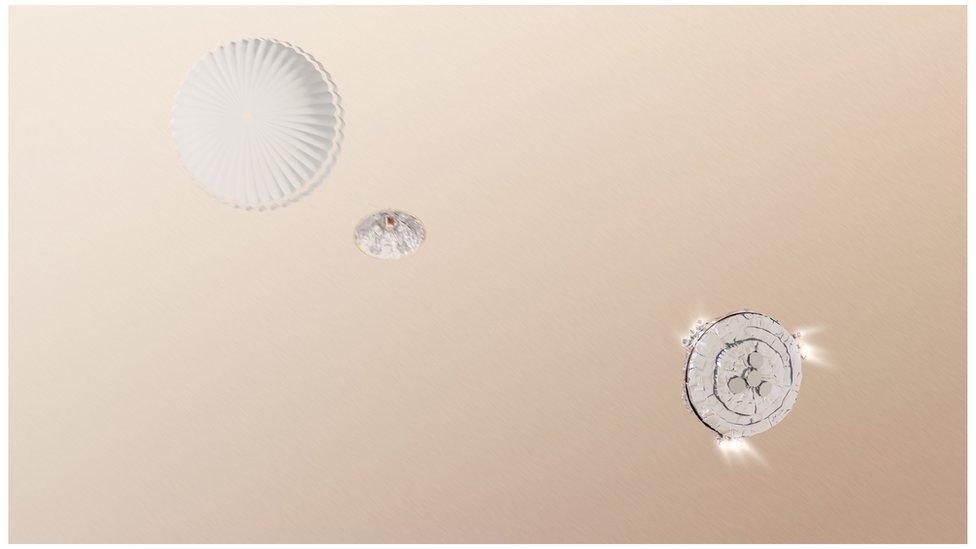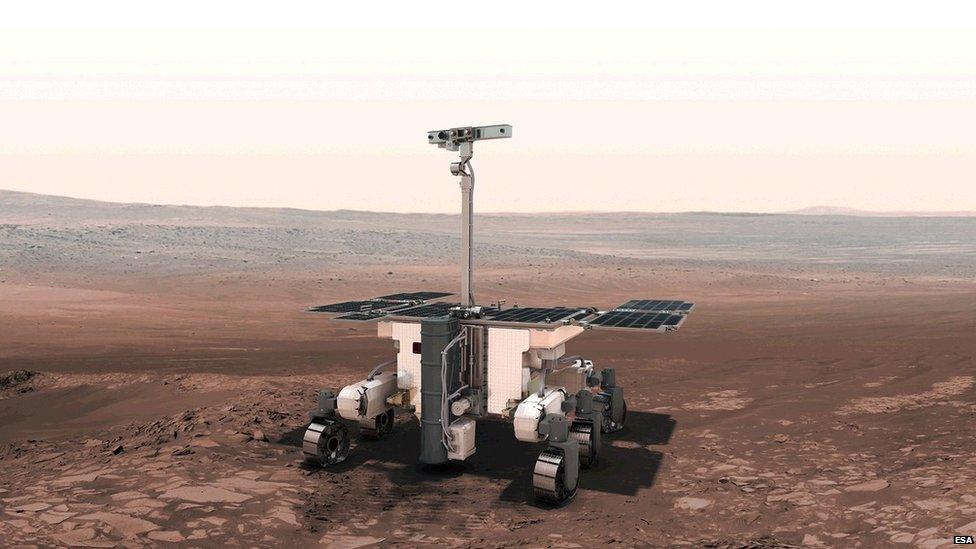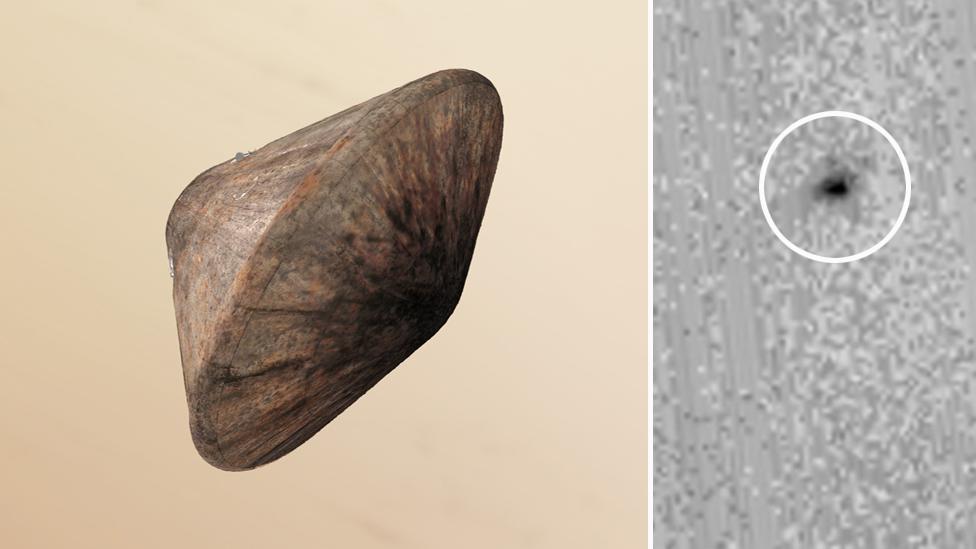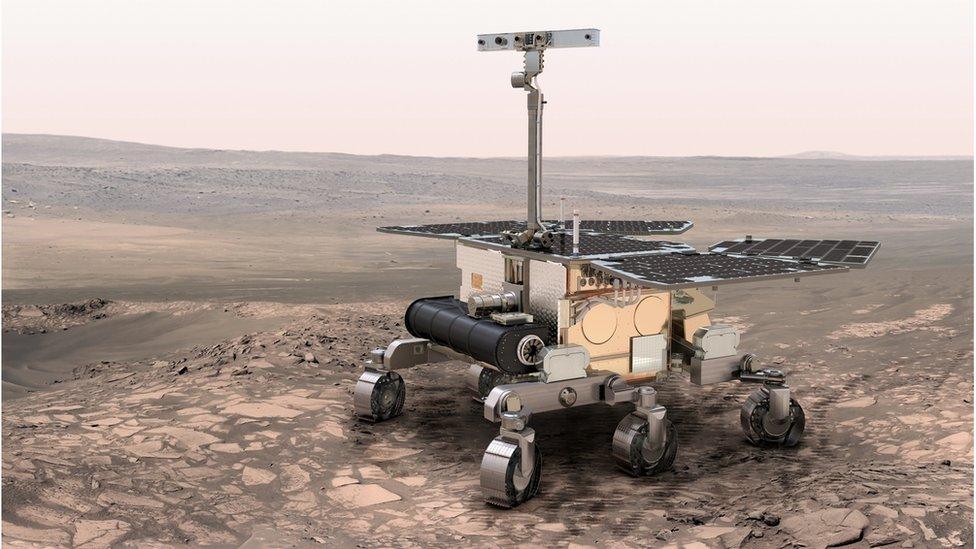Key meeting to weigh Mars crash report
- Published

Artwork: The retrorockets should have fired for about 30 seconds
Engineers are close to identifying the cause of the crash that destroyed the Schiaparelli lander on Mars last month.
The European Space Agency’s director general said he expected to have at least an interim report for member states when they meet to discuss future plans in a fortnight’s time.
Attention is focussed on how the probe interpreted sensor readings during its ill-fated descent to the Red Planet.
Schiaparelli’s parachute and rocket system did not behave as expected.
The former was jettisoned too early and the latter fired for too short a period.
"The onboard computer had some problems taking data from different sources, and defining correctly the altitude; and because of that the engines were started for only three seconds which was not enough," explained Prof Jan Woerner.
"When the parachute was deployed, it worked. But then some acceleration happened that we do not understand. Was it that the parachute did not deploy fully? We do not know."
Esa and industry experts are reviewing the telemetry, which the DG said the probe continued to transmit right up to the moment of its catastrophic impact with Mars’ equatorial Meridiani Plain.
A Schiaparelli mishap report is just one of the topics delegations will discuss when they meet on 21/22 November to review the status of the ExoMars programme - the joint venture Esa is running with Russia to explore the Red Planet.
Schiaparelli's landing sequence - stage by stage
Top of the agenda is the funding and schedule for the follow-on robot, which is a six-wheeled rover to be assembled in the UK.
Some of Schiaparelli’s technology is due to be used in the descent and landing system for this vehicle. Hence, the requirement for precise insight on what happened back on 19 October.
But the biggest issue facing the rover right now is a shortage of cash to carry it through to completion.
Member states will need to find an additional €300m-400m (currently £270m-360m; $330m-440m) to build, launch and operate the rover.
They have already delayed the life-seeking robot several times and there is a feeling now that unless its future is totally resolved, the project could well be binned.

Artist's impression: The robot rover will aim to drill below Mars' surface to look for life
Mr Woerner said he wanted to see an unequivocal commitment to plug the outstanding funds, and an end to the piecemeal, or "salami", support that has sustained rover development to date.
"Full transparency is necessary and it only makes sense for member states to commit the whole amount," he asserted.
"We need clear wording from the member states that we are going to pay that bill. Either we do it or we stop it, and I’m in favour of doing it," he told BBC News.
A final decision on the future of the ExoMars rover is unlikely to be made at the 21/22 November meeting.
In all probability, this will come a few days later when European research ministers gather in Lucerne, Switzerland.
It is at this summit, on 1/2 December, that funds must be pledged to a great swathe of Esa programmes, including future participation in the space station and the development of new Earth-observation satellites.

Schiaparelli's crash site (Left), parachute (Top-right) and heat shield (Bottom-right) have been imaged by satellite
Projects with a total value of €11bn (presently £9.8bn; $12.2bn) will be on the table, although it is highly uncertain at the moment what proportion of this request Esa will end up receiving.
Some ministers have yet to decide their priorities or budgets.
For example, the UK delegation is still waiting for Treasury guidance on what the post-Brexit slump in the value of Sterling means for its purchasing power at the summit.
If the Treasury decides not to underwrite the lost value, the British delegation will have substantially less money to play with as it considers which projects to back - and that includes ExoMars where it is a senior partner.

Jonathan.Amos-INTERNET@bbc.co.uk, external and follow me on Twitter: @BBCAmos, external
- Published27 October 2016

- Published21 October 2016

- Published20 October 2016
- Published2 May 2016
